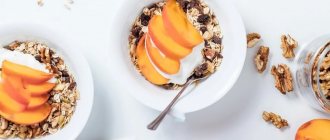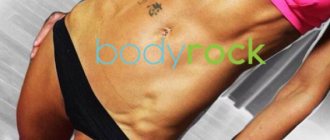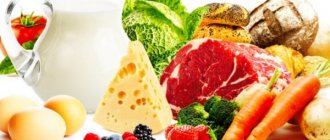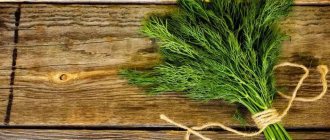Why do you need a calorie table?
This is a convenient tool for finding out the amount of proteins, fats and carbohydrates in your diet. When losing weight, it is important to take into account this balance, as well as the calorie content of dishes, excluding from the menu what prevents you from losing excess weight. However, to effectively lose weight you don’t have to give up your favorite foods. If you want to quickly get rid of extra pounds, you can include the Formula 1 protein shake from Herbalife Nutrition in your diet. This product forms the basis of a weight loss program. The product composition contains whey protein, which gives a long-lasting feeling of fullness, as well as a vitamin and mineral complex that saturates the body with essential nutrients. Regular consumption of Formula 1 as a complete replacement for breakfast or dinner in combination with physical activity can promote rapid fat burning.
Who is the table suitable for?
The calorie content of foods is an indicator you need to know:
- Those who want to lose weight. Thanks to such a table, you will be able to create a competent diet, excluding inappropriate foods from it. In addition, you can prepare a menu for the day or week, develop a suitable diet for weight loss, taking into account sports activities.
- Those who want to gain weight. In order to achieve results, it is also necessary to correctly adjust the diet by including more protein, slow carbohydrates and vegetable fats. A convenient table of calorie content per 100 grams of food will come to the rescue.
- Taking care of your own health. People who are forced to adhere to certain diets for indications must adjust their diet in accordance with the recommendations of doctors. The calorie table will help you avoid harmful foods and choose the most healthy menu.
Breakfast - the most important calories
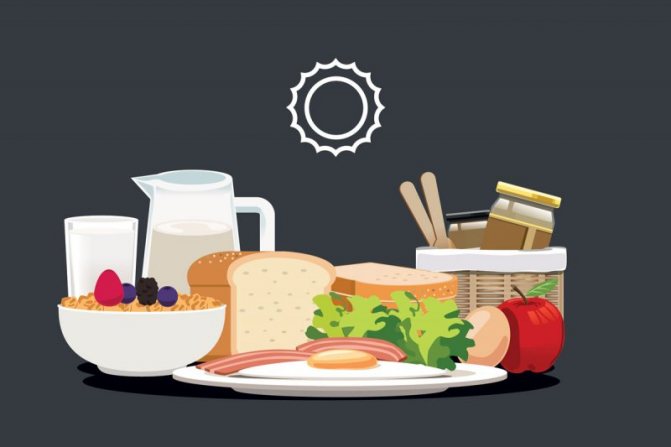
Research suggests that eating a nutritious breakfast speeds up your metabolism throughout the day, helping not only to control your appetite, but also improve the functioning of all body systems². People who eat enough calories at breakfast are less likely to overeat at lunch and dinner.
The recommended calorie content for breakfast is 400 kcal for women and 600 kcal for men. At the same time, proper nutrition involves eating fruits, oatmeal, eggs and natural yogurt - while pastries, bread, sausages, hot dogs and dry cereal for breakfast are not advisable.
// Read more:
- oatmeal for breakfast - what's the benefit?
- how many eggs can you eat a day
- bread - which is the healthiest?
Lunch
If you have breakfast early enough, it is permissible to eat a healthy snack closer to noon - this will help control calories at lunch. The best choice would be sources of fiber and healthy fats of about 150-200 kcal - for example, unsweetened fruit or a handful of nuts.
Also in a diet for weight loss, goji berries, chia seeds or flax seeds can be a second breakfast. They are low in calories, but they create a feeling of fullness and perfectly reduce appetite. They can be taken either in dry form with water (a tablespoon is enough) or in the form of a smoothie.
// Read more:
- Chia seeds or flax seeds - which is better?
- why do you always want to eat?
- smoothie - what is it?
Calorie content of ready meals
Here we have compiled a list of the most popular dishes that can be found in the diet of every person. The table shows the composition of BJU, as well as calorie content per 100 grams of product.
| Name | B | AND | U | Kcal |
| Beef azu | 12 | 14,2 | 10,2 | 215 |
| Chops | 27,8 | 30 | 2 | 385 |
| Pancakes with kefir | 6,1 | 12,3 | 26 | 234 |
| Borsch | 1 | 2 | 6,7 | 50 |
| Potato dumplings | 4,5 | 3,8 | 18,6 | 125 |
| Chicken cutlets | 18 | 10,5 | 13,7 | 221 |
| Boiled chicken fillet | 30,4 | 3,5 | 0 | 153 |
| Paste | 3,5 | 5 | 19 | 135 |
| Okroshka with meat on kvass | 2,1 | 1,7 | 6,3 | 53 |
| Dumplings | 12 | 13 | 29 | 275 |
| Traditional pilaf | 4,2 | 6 | 14,9 | 150 |
| Salad with crab sticks | 9,2 | 7,4 | 5,9 | 128 |
| "Caesar" | 15 | 10 | 9 | 190 |
| Pea soup | 4,4 | 2,4 | 8,9 | 66 |
Calorie food corridor
The caloric intake range is the gap between the upper and lower limits of the number of calories you consume per day to maintain weight or lose weight.
To lose weight, you shouldn't exceed the upper limit of your caloric intake, but if you go below the lower limit, your health may be at risk. In order to burn 1 kg of fat tissue, you need to burn 9,000 calories more than you previously consumed. This needs to be done gradually, not in one day, of course; There is no need to rush and extremely lower the caloric intake level, otherwise you will cause damage to the body. Therefore, you need to correctly calculate the caloric intake range in order to know your limits.
First, let's calculate the basal metabolic rate.
The basal metabolic rate for men is 660 + (13.7 × body weight in kg) + (5 × height in cm) - (6.8 × age in years).
The basal metabolic rate for women is 655+(9.6 × body weight in kg)+ (1.8 × height in cm) - (4.7 × age in years).
Now you need to multiply the resulting number by the activity factor:
- low activity, sedentary work x 1.2;
- average activity (light physical activity 1-3 times a week) x 1.375;
- high activity (intense physical activity 3-5 times a week) x 1.55;
- very high activity (intense physical activity 6-7 times a week) x 1.725;
- extreme physical activity (hard physical work, intense physical activity twice a day, competitions, etc.) x 1.9.
The resulting number is the number of calories you need to maintain your weight. Reduce this number by 20% - this is the daily caloric intake at which you will steadily lose weight without harm to your health.
The caloric intake corridor will be the gap between the first indicator (for maintaining weight) and the second (for losing weight). Based on these numbers, you can create your calorie menu. To do this, you will need to use the nutritional information provided on food packages and nutritional charts. Carefully count the calories in your diet and stay within your calorie range.
Calorie content of meat products and fish
When choosing a suitable diet, pay attention to the amount of carbohydrates. Meat and fish are great for the keto diet.
| Name | B | AND | U | Kcal |
| Beef | 18,7 | 12 | 0 | 191 |
| Pork | 16,3 | 27,6 | 0 | 318 |
| Veal | 19,6 | 1,1 | 0 | 91 |
| Chicken | 20,5 | 8,6 | 0,8 | 161 |
| Duck | 16,7 | 61,3 | 10 | 348 |
| Mutton | 16,2 | 15,3 | 0 | 201 |
| Perch | 17,5 | 5,6 | 0 | 123 |
| Saira | 18,4 | 20,6 | 0 | 257 |
| Salmon | 21 | 15,5 | 0 | 222 |
| Halibut | 18,6 | 3,3 | 0 | 106 |
The information is presented according to the book “Modern tables of calorie content of foods” [1].
Diet menu for weight loss for a week
1 day
- Sandwich with cheese and lettuce with butter. Coffee or tea of your choice.
- Cottage cheese 0-5% fat, fruit of your choice.
- Steamed chicken or turkey breast along with vegetables. Tea or mineral water.
- Fruit salad.
- Boiled fish with broccoli. Fruit drink or mineral water.
Day 2
- Oatmeal with pieces of fruit. Tea or coffee.
- A glass of kefir or fermented baked milk 1-2.5%.
- Meat with vegetables, steamed or in the oven. Tea or mineral water.
- Fruit of your choice.
- Fish cutlets with vegetable salad. Mineral water.
Day 3
- Omelet with a piece of bread. Tea or coffee.
- Sandwich with vegetables.
- Buckwheat with steamed meat cutlets. Dried fruits compote.
- A glass of yogurt.
- Boiled fish with vegetables. Mineral water.
4 day
- 2 boiled eggs. Tea or coffee.
- Cottage cheese.
- Pasta with vegetable dressing. Tea or mineral water.
- Fruit of your choice.
- Boiled fish with green beans or broccoli. Mineral water or dried fruit compote.
5 day
- Oatmeal with fruits and nuts. Tea or coffee.
- Fruit of your choice.
- Meat cutlets with vegetables. Dried fruits compote.
- Sandwich with vegetables.
- Curd cheesecakes and fruit salad. Mineral water.
Day 6
- Cottage cheese casserole with fruit. Tea or coffee.
- Vegetable or fruit smoothie.
- Vegetable soup with stuffed zucchini and rice. Tea or mineral water.
- Granola made from fresh fruits, nuts and low-fat yogurt.
- Pink salmon steak with vegetable salad. Mineral water.
Day 7
- Semolina with fruits and berries. Tea or coffee.
- Yogurt and cheese sandwich.
- Chicken breast with vegetables in soy sauce. Fruit drink or compote.
- Toast with vegetables.
- Salad of vegetables, nuts and seafood. Mineral water.
The table of caloric content of products and ready-made meals allows you to save time on independently searching for data on certain products, as well as on calculating the daily calorie intake.

Although all data has been carefully calculated, the actual calorie content of each dish will differ slightly from those presented in the table. The reason for this is different recipes, products and cooking methods. But since there is no point in sending every portion of food for examination, you can use the average values from the tables without losing the quality of the calculations.
Calorie content of dairy products
Dairy products are a valuable source of protein. However, not all dishes can provide the required dose of protein. An additional source of valuable amino acids can be the Formula 3 protein mixture from Herbalife Nutrition. It is recommended to use it in combination with Formula 1: this way you can get more benefits and adjust your diet specifically for weight loss. Such a product can completely replace one of your meals, saturating the body for a long time and helping to fight hunger. In the table below you can see the calorie content of dairy products. You can calculate the exact calorie content of a dish using a special calculator.
| Name | B | AND | U | Kcal |
| Milk 2.5% | 2,8 | 2,5 | 4,8 | 52 |
| Kefir | 2,8 | 1 | 4 | 40 |
| Natural yogurt | 4,3 | 2 | 6,2 | 60 |
| Hard cheese | 26 | 26,8 | 0 | 352 |
| Soft cheese | 17 | 11,3 | 23,9 | 257 |

Lunch calories
Lunch is the second most important meal for the body after breakfast. It is very important that he is full and not hungry, otherwise there is a chance he will break down and overeat during dinner. The calorie content of lunch should be 35-40% of the daily calorie intake and range from 500 to 800 kcal.
Healthy foods for the menu with a calorie content not exceeding 800 kcal per serving are meat, fish, vegetables, fruits, fermented milk products, a variety of soups and broths, mushrooms and legumes. Also during lunch, you can eat a little dessert prepared yourself - this is the only way to be sure that it will consist of healthy and fresh ingredients, and not from saturated trans fats and light carbohydrates, the consumption of which leads to the accumulation of fat and excess weight in the body . A properly prepared dessert will not have a negative impact on the calorie content of lunch; the main thing is not to overdo it with portions. Recipes for delicious and healthy desserts are:
- Recipe 1 – kefir pancakes with apples. To prepare one serving of pancakes, allowing you to maintain a low level of caloric intake, you need to beat one egg, 50 g of sugar and 150 g of 0% kefir with a mixer. Then add half a cup of whole grain flour and a quarter tsp to the resulting mixture. soda and beat again with a mixer. One large apple must be peeled, cored and pitted, cut into small slices and placed in the finished dough. It is advisable to cook pancakes in a ceramic frying pan without oil. The finished pancakes can be sprinkled with cinnamon and a small amount of powdered sugar or sprinkled with a few tablespoons of any syrup or jam;
- Recipe 2 – ginger charlotte. To prepare charlotte, which allows you to maintain a low level of caloric intake and is designed for 4 servings, you need to beat the whites of 4 eggs with 150 g of sugar, and with another 150 g of sugar you need to beat the yolks of 4 eggs, and then combine them together. Then, 1 cup of whole grain flour, half a tsp are gradually added to the resulting mixture. baking soda, a glass of warm water and a pinch of salt. Fresh ginger root (100-150 g, more is possible, but then the charlotte will be quite “savory”) should be grated on a fine grater, added to the dough and mixed thoroughly. The charlotte should be baked in a mold, greased with butter and sprinkled with semolina, for half an hour or 40 minutes at a temperature of 180°C;
- Recipe 3 – panna cotta with berries. To prepare a delicious berry panna cotta, which allows you to maintain a low level of caloric intake, you need to mix one pack of gelatin with 150 ml of cool water and bring it to full readiness (until it swells). Then mix 200 ml of 15% homemade cream with 100 g of sugar and 100 ml of cool water, put on fire and cook for 15 minutes, stirring continuously and without bringing to a boil. Afterwards, you need to add ready-made gelatin to the prepared hot mixture, mix thoroughly, pour into molds and cool overnight in the refrigerator. Beat 200 g of fresh berries (strawberries, raspberries and blueberries) with a blender and mix with 30 g of powdered sugar, after which the finished berry sauce is poured over the finished panna cotta.
The calorie content of a lunch with such desserts will not increase much, and eating such delicious dishes has a beneficial effect on a person’s health and mood.

